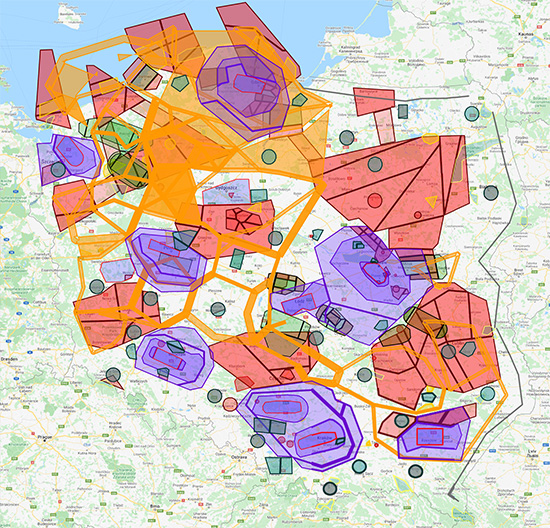Accessibility Tools
The Aeronautical Information Publication (AIP) for the Warszawa FIR (AIP Poland) is published and distributed by the Polish Air Navigation Services Agency.
AIP Poland is compliant with the Standards and Recommended Practices (SARPs) contained in Annex 15 to the Convention on International Civil Aviation – Aeronautical Information Services, and supplementary documents: Aeronautical Information Services Manual (ICAO Doc 8126) and Doc 10066 Procedures for Air Navigation Services – Aeronautical Information Management (PANS-AIM).
Charts contained in the Aeronautical Information Publication (AIP) of Poland, compliant to the standards described in Annex 4 to the Convention on International Civil Aviation – Aeronautical Charts and recommendations specified in the Aeronautical Charts Manual (ICAO Doc 8697) contain the “ICAO” abbreviation in their names, e.g. Aerodrome Chart – ICAO.
Differences from ICAO Standards, Recommended Practices and Procedures are shown in chapter GEN 1.7.

Layout of AIP Poland is a three-volume product, which consists of:
– AIP Poland – eAIP IFR
– AIP Poland – eAIP VFR
– AIP Poland – MIL eAIP
The thematic layout of information published in AIP Poland is compliant with ICAO Doc 8126 and Doc 10066. Detailed information on contents of particular chapters is given in tables of contents.
AIP Poland is published only in electronic version, available on MS Sharepoint service. More information available in Sale & Order tab.
AIRAC Amendments are published when needed in accordance with dates of the AIRAC cycle. These Amendments are distributed to reach subscribers at least 28 (in special cases 56) days in advance of their effective date.
AIP Poland – eAIP IFR is published and promulgated by the Polish Air Navigation Services Agency. It contains general information on rules and procedures applicable to IFR flights within the WARSZAWA FIR.
AIP Poland – eAIP IFR consists of the following parts:
– GEN,
– ENR,
– AD 2.
VFR GEN briefly describes information necessary for performing flights in IFR conditions. ENR part contains regulations relating to IFR traffic. Information on Aerodromes subject to Instrument Flight Rules, as well as related charts, are listed in AD 2.
Separate Amendments, Supplements and hand amendments are prepared to AIP Poland – eAIP IFR. All Amendments and updates are published in accordance with AIRAC cycle. Charts contained in AIP IFR are not fully compliant with standards described in Annex 4 to the Convention on International Civil Aviation – Aeronautical Charts.
AIP Poland – eAIP VFR is published and promulgated by the Polish Air Navigation Services Agency. It contains general information on rules and procedures applicable to VFR flights within the WARSZAWA FIR.
AIP Poland – eAIP VFR consists of the following parts:
– VFR GEN,
– VFR ENR,
– VFR AD 4.
VFR GEN briefly describes information necessary for performing flights in VFR conditions. VFR ENR part contains regulations relating to VFR traffic. Information on Aerodromes and Airfields subject to Visual Flight Rules, as well as related charts, are listed in VFR AD 4.
Separate Amendments, Supplements and hand amendments are prepared to AIP Poland – eAIP VFR. All Amendments and updates are published in accordance with AIRAC cycle. Charts contained in AIP VFR are not fully compliant with standards described in Annex 4 to the Convention on International Civil Aviation – Aeronautical Charts.
AIP Poland – MIL eAIP is published by the Polish Air Navigation Services Agency (PANSA) in cooperation with the Military Air Traffic Service Office of the Polish Armed Forces. The Aeronautical Publication and Procedures Design Branch of the Military Air Traffic Service Office (Polish Armed Forces) is responsible for collecting and providing PANSA with aeronautical data related to military aerodromes.
AIP Poland – MIL eAIP contains general information on regulations and flight rules applicable to military aviation. The publication does not fully conform to the Standards and Recommended Practices of Annex 15 to the Convention on International Civil Aviation – Aeronautical Information Services.
AIP Poland – MIL eAIP consists of the following parts:
– MIL GEN,
– MIL ENR,
– MIL AD 4.
General information necessary for military aviation to carry out flights is presented in the MIL GEN part. The MIL ENR part contains basic information on the WARSZAWA FIR Airspace and general information related to Visual Flight Rules and Instrument Flight Rules.
AIP Poland – MIL eAIP is updated by means of separate MIL eAIP Amendments, MIL eAIP Supplements and Hand Amendments. Information qualifying for publication as a Supplement and concerning civil aerodromes and civil flight operations is available in Supplements to AIP Poland – AIP IFR. Any Amendments and updates are incorporated into AIP Poland – MIL eAIP in accordance with the AIRAC system.
During the edition process of AIP Poland special care is applied to detailed and appropriate presentation of information. In case any errors would be found or in case of any doubts all related correspondence shall be addressed to:
Postal address:
Polska Agencja Żeglugi Powietrznej
Służba Informacji Lotniczej
ul. Wieżowa 8
02-147 Warszawa
Polska
Phones.: +48-22-574-5625, 5624 lub 5694
Fax: +48-22-574-5619
AFS: EPWWYOYX
E-mail: ais.poland@pansa.pl
WWW: https://www.ais.pansa.pl